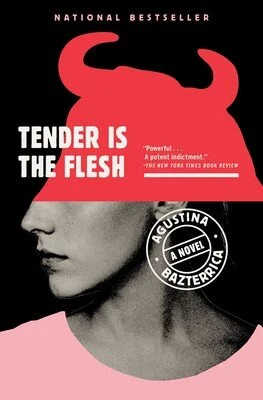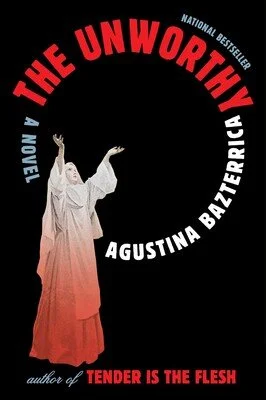There Is No Refuge: A Review of Agustina Bazterrica’s The Unworthy
by Savannah Brooks
Image from Beth Macdonald
Tender is the Flesh by Agustina Bazterrica,
translated by Sarah Moses.
Scribner, 2020.
With her debut novel, Tender is the Flesh (translated into English in 2020), Argentinian writer Agustina Bazterrica cemented herself as a literary tour de force of horrific mundanity—that is, of what society can convince itself is normal. The world of Tender is the Flesh, in which all animals have been eradicated by disease and where cannibalism has been capitalized upon, is an eerie shadow of our own. Bazterrica’s latest book, The Unworthy (published in the US in March 2025 by Scribner), contains a nod to this world—“The Superior Sister ordered the servants to shelter the animals (which we’ve never seen, not near the crops, not in a corral—do they even exist?)”—but delves deeper, unfolding into an all-too-real projection of what a climate disaster may look like in the not-too-distant future:
I found a box of mobile phones that were turned off. My mother had told me about them, from when there was internet, she’d said. When the world still believed the internet was going to last forever. Now the phones are worthless. Black screens and silence. That’s what Mom had said, black screens and silence, and she’d showed me her useless mobile, told me what the world had been like before, how people had done everything on those screens, how they believed that in some countries the electricity had been cut because of artificial intelligence, to prevent its advance, the spread of its power, its independence and hunger to dominate its creator. How after the final blackout the world did not recover, rebuild, restart, because nature finished things off with a new degree of devastation.
The Unworthy is undoubtedly horror—tension and fear permeate every page, along with death and cruelty and cockroaches—but by setting the story in a combined tech-climate disaster, Bazterrica pulls a strong current of science fiction in as well, playing on the globe’s most pressing anxieties, and the two genres only heighten each other. Horror is the art of emotional manipulation. Science fiction is, as Ray Bradbury coined it, the art of the possible.
The Unworthy by Agustina Bazterrica,
translated by Sarah Moses.
Scribner, 2025.
“It is, after all, the fiction of ideas, the fiction where philosophy can be tinkered with, torn apart, and put back together again,” he wrote in an essay titled “Day After Tomorrow,” published May 2, 1953, in The Nation. “It is the fiction of sociology and psychology and history compounded and squared by time. It is the fiction where you may set up and knock down your own political and religious and moral states.”
In other words, science fiction allows the writer to ask “what if” and then write themselves the answer.
In The Unworthy, Bazterrica asks: What if floods, fires, hurricanes, droughts, and their ensuing violence decimated the globe? How would the survivors start over again? And in such a brutal world, who would they have to become in order to survive in the first place?
Then she tells us.
In one last sanctuary carved out from the apocalypse, the Sacred Sisterhood, a group of survivors dwells within a convent that used to be a monastery. The monks have died—have been killed off—as has their religion: “The stained glass was smeared with black paint. The glass with images of the erroneous God, the false son, the negative mother, the God unable to contain the avarice and stupidity of his flock, the God who let them poison the nucleus of the only thing that mattered. This God, who left us adrift in a poisoned world, cannot be named or looked at.”
The reader knows almost nothing about this place, what its rules are, or how it even came to be. It’s a mystery that unravels with each unbearably tense detail, each reference to the story’s grotesque cockroach motif. The reader also knows almost nothing about the unnamed narrator—who seems to know almost nothing about herself. She indicates her lapses in memory over and over, with words and sentences that have been stricken throughout the manuscript. The reader knows the narrator is keeping a Handmaid’s Tale–style journal, but—once again—they don’t know why. They don’t understand why the narrator keeps censoring herself; they don’t know what it is she’s refusing to recall; they don’t know how she got to the convent or who she was before she became one of the Unworthy. They don’t even know what it means to be Unworthy, except that it’s bad. The unnamed Him, along with his partner, the Superior Sister, makes that very clear when he addresses the Unworthy:
“How do you expect the Enlightened to protect this lot of apathetic, unworthy women? Why would they bother sheltering mistrustful, skeptical, inconsiderate bitches who drag themselves through the earth, filthy and drooling like a pack of blasphemous, suspicious, wavering women? Without faith, there is no refuge.”
The Unworthy are the lowest in a hierarchy of women trapped within the convent both by a cruel dictator and an unforgiving climate. They stand below the rank of the Chosen, who stand below the rank of the Enlightened. Every Unworthy woman wants to be Enlightened but few want to be Chosen, and it’s not hard to see why: “Beyond [the door] is the Refuge of the Enlightened. They don’t live with the Chosen because they’re the Sacred Sisterhood’s most valued treasure (that’s why they’re not mutilated like the three orders of the Chosen—the Minor Saints, the Diaphanous Spirits, and the Full Auras.)”
And that’s before the Chosen start showing up dead.
Though the murders are central to the plot, that arc is the only one that isn’t a mystery. The narrator is well aware of who the most likely suspects are—everyone is, including the reader—but they’re powerless against Him and the Superior Sister. They’re powerless to the environment of suspicion, hatred, and fear that He and the Superior Sister have created, nearly as powerless as they are to the actual toxins flooding the environment.
The mystery isn’t “How did this come to be?” It’s “How did we allow this to happen?”
Fahrenheit 451 by Ray Bradbury. Simon & Schuster, 2012.
The 60th anniversary edition of Fahrenheit 451 (published in 2013 by Simon & Schuster) contains a transcript of Ray Bradbury’s audio introduction to the novel. In it, he describes why he chose science fiction as its genre:
I believe in having fun first, and along the way, if you teach people, if you influence people, well and good. But I don’t want to set out to influence people. I don’t want to set out to change the world in any self-conscious way. That way leads to self-destruction; that way, you’re pontificating, and it’s dangerous and it’s boring—you’re going to put people right to sleep.
So instead of doing that—I’ve always loved adventure stories, I’ve always loved adventure films. I’ve loved murder mysteries and science fiction adventures. I took a framework, then, of a suspense—actually a pursuit and escape thing—and you then hang on all the things that you want to say, all the things that you want to do, about a particular time that you live in, about a time that you would like to prevent, because I’m a preventer of futures, I’m not a predictor of them.
Bazterrica employs this same stylistic choice to a chilling effect. There is a moral point to the story, but it isn’t as clear-cut as one would expect. Mirroring reality, Bazterrica doesn’t offer an easy answer. She doesn’t whittle the globe’s most complex issues into mere plot points. She doesn’t suggest a path to salvation.
Instead, she pulls us in with the promise of tension, of horror, and then layers meaning and nuance on top of all that tension and horror. She writes us into a claustrophobic microcosm that is undoubtedly affected by the repercussions of humanity’s actions but that ultimately focuses internally, on the interpersonal relationships within the convent. She underscores that, even in the midst of famine and flooding and nuclear fallout, those small, everyday moments of empathy—or the lack thereof—are still integral to building a functioning society—or lack thereof. In placing the reader just beyond the point of no return, they’re forced to contend with the same helplessness as our unnamed narrator. They’re forced to see just how little can truly be done to prevent such a horrendous fate once it's been accepted as inevitable.
Without faith—without the belief that we, as society, can do better—there is no refuge. Within the Sacred Sisterhood, there is no refuge either. There’s only a cautionary tale. A future we must prevent.
Savannah Brooks earned her MFA in creative writing from Hamline University and spent the first decade of her career working in publishing, first as an editor and then as a literary agent. After contracting a debilitating illness, she left the field to focus on writing and teaching. Among other publications, her short stories have been featured in Prime Number Magazine, New Plains Review, and Inscape; her essays in The Guardian, Hobart, and Barely South Review; and her book reviews in Oyster River Pages, the Hong Kong Review, and Bridge Eight. A disabled writer suffering from the most literal of broken hearts (and stomachs), she lives in the mountains of Asheville, North Carolina, with her two black cats, Eggs Benedict and Toaster Strudel. You can find more at savannahbrooks.com.






